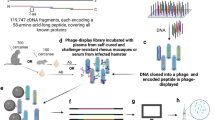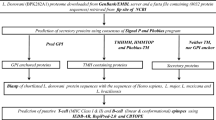Abstract
The tegument of schistosomula contains T cell antigens that might simulate the protective mechanisms of the radiation-attenuated vaccine in a mouse model of schistosomiasis. Immune mechanisms mediated by the CD4+ Th1 response are important in the RAV model. To rapidly identify Th1 epitopes in molecules from the Schistosoma japonicum schistosomula tegument, this study analyzed S. japonicum proteomics data. Preliminary experiments identified a protein similar to prosaposin (SjPSAP) from the tegument of schistosomula. We confirmed that SjPSAP was present in the tegument of the parasite using an indirect immunofluorescence assay. We then identified Th cell epitopes in SjPSAP using in silico prediction combined with experimental validation. From the SjPSAP sequence, we used several algorithms to predict 11 promiscuous Th cell epitopes that might bind to both murine and human MHC class II molecules. To validate the in silico predictions, proliferation and cytokine production profiles of spleen lymphocytes from BALB/c mice immunized with the 11 predicted peptides were measured in vitro using a modified methyl thiazolyl tetrazolium assay and flow cytometry. The results showed that 4 of the 11 predicted peptides induced a recall CD4+ Th1 response in vitro. We measured direct binding of the four peptides predicted to induce a response to antigen-presenting cells from BALB/c mice using a fluorometric method and found that the peptides bound to both I-Ad and I-Ed mouse molecules. These results demonstrated that potentially protective Th1-type epitopes in SjPSAP molecules could be identified rapidly by combining in silico prediction with experimental validation. This strategy could be a fast method for identifying Th1 epitopes in a schistosoma antigen with features such as large size or poor expression of recombinant antigens.




Similar content being viewed by others
References
Abdul-Ghani RA, Hassan AA (2010) Murine schistosomiasis as a model for human schistosomiasis mansoni: similarities and discrepancies. Parasitol Res 107(1):1–8
Berzofsky JA, Pendleton CD, Clerici M, Ahlers J, Lucey DR, Putney SD, Shearer GM (1991) Construction of peptides encompassing multideterminant clusters of human immunodeficiency virus envelope to induce in vitro T cell responses in mice and humans of multiple MHC types. J Clin Invest 88:876–884
Bickle QD (2009) Radiation-attenuated schistosome vaccination—a brief historical perspective. Parasitology 136(12):1621–1632
Cardoso FC, Macedo GC, Gava E, Kitten GT, Mati VL, de Melo AL, Caliari MV, Almeida GT, Venancio TM, Verjovski-Almeida S, Oliveira SC (2008) Schistosoma mansoni tegument protein Sm29 is able to induce a Th1-type of immune response and protection against parasite infection. PLoS Negl Trop Dis 2(10):e308
Chen L, Yang JM, Chen H, Yuan CX, Shao DH, Feng XG, Lin JJ (2009) Prediction and identification of T helper cell epitopes in tegument molecule of schistosomulum of Schistosoma japonicum. Zhongguo Xue Xi Chong Bing Fang Zhi Za Zhi 21(2):87–92
Contreras CE, Ploton IN, Siliciano RF, Karp CL, Viscidi R, Kumar N (1998) Mapping of specific and promiscuous HLA-DR-restricted T-cell epitopes on the Plasmodium falciparum 27-kilodalton sexual stage-specific antigen. Infect Immun 66(8):3579–3590
Espino AM, Torres D, Morales A, Delgado B, Quetel J, Osuna A (2007) Fasciola hepatica: identification of CD4+ T-helper epitopes from the 11.5 kDa saposin-like protein SAP-2 using synthetic peptides. Exp Parasitol 117(1):65–73
Fonseca CT, Cunha-Neto E, Goldberg AC, Kalil J, de Jesus AR, Carvalho EM, Correa-Oliveira R, Hammer J, Sidney J, Sette A, Oliveira SC (2005) Identification of paramyosin T cell epitopes associated with human resistance to Schistosoma mansoni reinfection. Clin Exp Immunol 142(3):539–547
Fonseca CT, Braz Figueiredo Carvalho G, Carvalho Alves C, de Melo TT (2012) Schistosoma tegument proteins in vaccine and diagnosis development: an update. J Parasitol Res 2012:541268
Gan XX, Shen LY, Wang Y, Ding JZ, Shen HY, Zeng XP, McManus DP, Brindley PJ, Fan J (2006) Recombinant tegumental protein Schistosoma japonicum very low density lipoprotein binding protein as a vaccine candidate against Schistosoma japonicum. Mem Inst Oswaldo Cruz 101(1):9–13
Garg N, Raghava GPS (2008) ESLpred2: improved method for predicting subcellular localization of eukaryotic proteins. BMC Bioinformatics 9:503
Horton P, Park KJ, Obayashi T, Fujita N, Harada H, Adams-Collier CJ, Nakai K (2007) WoLF PSORT: protein localization predictor. Nucleic Acids Res 35(Web Server issue):w585-w587
Lei ZL, Zheng H, Zhang LJ, Zhu R, Guo JG, Li SZ, Wang LY, Chen Z, Zhou XN (2011) Schistosomiasis status in People's Republic of China in 2010. Zhongguo Xue Xi Chong Bing Fang Zhi Za Zhi 23:599–604
Liu F, Lu J, Hu W, Wang SY, Cui SJ, Chi M, Yan Q, Wang XR, Song HD, Xu XN, Wang JJ, Zhang XL, Zhang X, Wang ZQ, Xue CL, Brindley PJ, McManus DP, Yang PY, Feng Z, Chen Z, Han ZG (2006) New perspectives on host-parasite interplay by comparative transcriptomic and proteomic analyses of Schistosoma japonicum. PLoS Pathog 2:e29
Meister GE, Roberts CG, Berzofsky JA, De Groot AS (1995) Two novel T cell epitope prediction algorithms based on MHC-binding motifs; comparison of predicted and published epitopes from Mycobacterium tuberculosis and HIV protein sequences. Vaccine 13(6):581–591
Mozes E, Dayan M, Zisman E, Brocke S, Licht A, Pecht I (1989) Direct binding of a myasthenia gravis related epitope to MHC class II molecules on living murine antigen-presenting cells. EMBO J 8:4049–4052
Nandi B, Hogle K, Vitko N, Winslow GM (2007) CD4 T-cell epitopes associated with protective immunity induced following vaccination of mice with an ehrlichial variable outer membrane protein. Infect Immun 75(11):5453–5459
Qiu C, Hong Y, Cao Y, Wang F, Fu Z, Shi Y, Wei M, Liu S, Lin J (2012) Molecular cloning and characterization of glutamine synthetase, a tegumental protein from Schistosoma japonicum. Parasitol Res 111(6):2367–2376
Reda ES, Ouhtit A, Abdeen SH, El-Shabasy EA (2012) Structural changes of Schistosoma mansoni adult worms recovered from C57BL/6 mice treated with radiation-attenuated vaccine and/or praziquantel against infection. Parasitol Res 110(2):979–992
Skelly PJ, Wilson RA (2006) Making sense of the schistosome surface. Adv Parasitol 63:185–284
Tang CL, Lei JH, Wang T, Lu SJ, Guan F, Liu WQ, Li YL (2011) Effect of CD4+ CD25+ regulatory T cells on the immune evasion of Schistosoma japonicum. Parasitol Res 108(2):477–480
Teixeira de Melo T, Michel de Araujo J, Do Valle Durães F, Caliari MV, Oliveira SC, Coelho PM, Fonseca CT (2010) Immunization with newly transformed Schistosoma mansoni schistosomula tegument elicits tegument damage, reduction in egg and parasite burden. Parasite Immunol 32(11–12):749–759
Teixeira de Melo T, Araujo JM, Campos de Sena I, Carvalho Alves C, Araujo N, Toscano Fonseca C (2013) Evaluation of the protective immune response induced in mice by immunization with Schistosoma mansoni schistosomula tegument (Smteg) in association with CpG-ODN. Microbes Infec 15(1):28–36
Tian F, Hou M, Chen L, Gao Y, Zhang X, Ji M, Wu G (2013) Proteomic analysis of schistosomiasis japonica vaccine candidate antigens recognized by UV-attenuated cercariae-immunized porcine serum IgG2. Parasitol Res 112(8):2791–2803
Van Hellemond JJ, Retra K, Brouwers JF et al (2006) Functions of the tegument of schistosomes: clues from the proteome and lipidome. Int J Parasitol 36:691–699
Vázquez-Talavera J, Solís CF, Medina-Escutia E, López ZM, Proaño J, Correa D, Laclette JP (2001) Human T and B cell epitope mapping of Taenia solium paramyosin. Parasite immunol 23:575–579
Vordermeier M, Whelan AO, Hewinson RG (2003) Recognition of mycobacterial epitopes by T cells across mammalian species and use of a program that predicts human HLA-DR binding peptides to predict bovine epitopes. Infect Immun 71:1980–1987
Yuan CX, Li M, Chen YJ, Shi YJ, Wu XF, Cai YM, Lin JJ (2000). Construction of cDNA libraries from mature female and male worm of Schistosoma japonicum Chinese main land strain. Chin J Biotech 16:727–730
Zhang DM, Pan WQ, Qian L, Duke M, Shen LH, McManus DP (2006) Investigation of recombinant Schistosoma japonicum paramyosin fragments for immunogenicity and vaccine efficacy in mice. Parasite Immunol 28(3):77–84
Zhang SM, Lv ZY, Zhou HJ, Zhang LY, Yang LL, Yu X, Zheng H, Wu ZD (2008) Characterization of a profilin-like protein from Schistosoma japonicum, a potential new vaccine candidate. Parasitol Res 102(6):1367–1374
Zhang M, Han Y, Zhu Z, Li D, Hong Y, Wu X, Fu Z, Lin J (2012a) Cloning, expression, and characterization of Schistosoma japonicum tegument protein phosphodiesterase-5. Parasitol Res 110(2):775–786
Zhang YL, Jia K, Zhao BP, Li Y, Yuan CX, Yang JM, Lin JJ, Feng XG (2012b) Identification of Th1 epitopes within molecules from the lung-stage schistosomulum of Schistosoma japonicum by combining prediction analysis of the transcriptome with experimental validation. Parasitol Int 61(4):586–593
Zhao BP, Chen L, Zhang YL, Yang JM, Jia K, Sui CY, Yuan CX, Lin JJ, Feng XG (2011) In silico prediction of binding of promiscuous peptides to multiple MHC class-II molecules identifies the Th1 cell epitopes from secreted and transmembrane proteins of Schistosoma japonicum in BALB/c mice. Microbes Infect 13(7):709–719
Acknowledgments
This work was supported in part by the Special Fund for Agro-scientific Research in the Public Interest (grant no. 201303037) and Fund on Basic Scientific Research Project of Nonprofit Central Research Institutions ( 2012JB17 and 2013JB15).
Author information
Authors and Affiliations
Corresponding author
Additional information
Yan Li Zhang and Yun Yan Li contributed equally to the work.
Rights and permissions
About this article
Cite this article
Zhang, Y.L., Li, Y.Y., Zhao, B.P. et al. Molecular characterization and identification of Th1 epitopes of a Schistosoma japonicum protein similar to prosaposin. Parasitol Res 113, 983–992 (2014). https://doi.org/10.1007/s00436-013-3730-7
Received:
Accepted:
Published:
Issue Date:
DOI: https://doi.org/10.1007/s00436-013-3730-7




